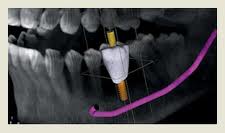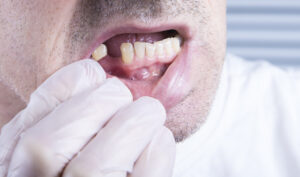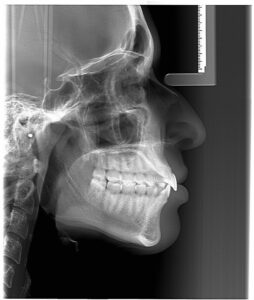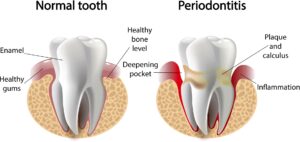Header logo
header top contact widget
grinding or clenching
Dental Implants – Lower Risks Of Failure With These Tips
Posted on Apr 21, 2022 by William J. Claiborne, DDS MS
In our Asheville periodontal dental office, we believe our patients appreciate being fully informed about their oral health status and understanding their options for treatment. For those who have lost natural teeth, our specialty dental services include the diagnosis and placement of dental implants.
The specialized skills of a periodontist provides implant patients with a high level of success in treatment outcome. It also offers patients a wider variety of choices when it comes to implant systems.
This is why many general dentists who offer dental implants refer the placement portion to a periodontal specialist. For their patient, this can mean a higher level of success, especially for complex needs.
For example, a patient who is missing a lot of bone mass (often due to missing natural teeth for many years) benefits from the specialized skills of our Asheville periodontal office. Another example is a patient who has lost teeth due to periodontal (gum) disease. Because a periodontist combines advanced skills in treating gum disease as well as in dental implants, these patients are given a ‘leg up’ when it comes to treatment success.
In making your decision to opt for dental implants vs. crown-&-bridge, dentures or partials, it is important to understand the basics of how dental implants work. Although there are different types of implant systems, all work in in a similar fashion.
An implant is similar to a screw-like cylinder that is hollowed out in the center. This segment is what is placed into the bone to serve as a tooth root replacement.
Selecting the most appropriate type of implant and how many are needed is based on specific needs and goals. Our Western NC periodontal office plans for your placement procedure using computerized technology to determine the precise angles and depths for each implant before the placement procedure begins. This minimizes disruption to the gum tissues and bone structures, which in turn reduces healing time and optimizes comfort.
Once placed, each implant is covered over with gum tissue. For several months after, the implant goes through a process known as “osseo-integration.” During this phase, the bone grows around the implant, securing it into the bone. This recreates the foundation of natural tooth roots to give biting and chewing stability. Throughout this time, you can wear a denture or temporary so you are never without teeth.
Once healing is complete, a post is secured inside the hollow core of the implant. This post (or “abutment”) will support your final replacement tooth or teeth.
An important aspect of implant success also relies on the proper assessment of bone mass. When the upper or lower jaw has insufficient bone to support the implant being placed, there is a risk of failure.
Again, an implant requires careful selection and placement to be able to support the replacement teeth being attached. In some cases, as few as 4 – 6 implants can support a complete arch of teeth. This decision is best left in the hands of a periodontal specialist.
Severe bone loss can require bone rebuilding procedures prior to implant placement. This can be done by bone grafting or the application of a bone-rebuilding material. In some cases, dental implant systems designed with unique angles (such as the “All On 4”) can support a fulll arch of upper or lower teeth using minimal bone depth with no bone rebuilding necessary.
Another perk of the All On 4 is the forces of chewing and biting require only 4 implants on the upper and/or lower. Because implant costs are largely based on the number of implants placed, this can be a great savings for people who are candidates.
Why does successful placement rely so greatly on assessing bone mass? An implant must be placed in adequate bone that does not risk interfering with adjacent structures.
Without proper placement in sufficient bone, an implant risks coming in contact with a nerve that extends horizontally through the lower jaw. Upper implants placed too close to the sinus cavity can, over time, penetrate that area. Removing an implant in either of these situations, of course, is no simple task.
The ability to select the proper implant type for available bone depth is equally important.
Dental implant diagnosis and placement skills can vary greatly from one dentist to another. While some have taken extensive courses in implant dentistry, others may have taken a weekend course here and there. These are typically ‘hosted’ by a particular manufacturer who provides ‘training’ in a limited selection of implant types. In turn, this can limit the patient’s choices when relying on appropriate recommendations for his or her unique needs.
Obviously, a qualified doctor can enhance your potential for a successful outcome, which is where a periodontal specialist is a wise choice. A Periodontist has particular expertise in the diagnosis and placement of all types of Dental Implants. As a matter of fact, many general dentists prefer to have a Periodontist place implants in their patients. The patient then returns to their dentist for the attachment of teeth to the implants.
Rest assured – in our office, comfort is always a priority. For our patients, we offer oral or I.V sedation to accompany many procedures. While both are beneficial to calm anxiety, tension, stress or even intense feelings of fear, each has its advantages as well as limitations.
Oral sedation is in pill form and provides a fully relaxed state. It often erases most memory of the procedure after and has a quick recovery.
While oral sedation provides a very relaxed state, I.V. sedation puts you in a complete sleep state. This is sometimes referred to as “twilight sleep.” I.V. sedation is ideal for people with dental fear or phobia. This sedation is delivered through an I.V. drip, or intravenously. It takes effect rather quickly and patients nod off within minutes. This sedative erases memory of treatment afterward.
Whether given oral or I.V. sedation, comfort and safety are important to us at all times. And, while sedation is helpful when fear or anxiety exist, some people who have no fears at all request sedation for its ability to relax them during lengthy appointments.
While the doctor involved in your treatment is important, much of the potential for a successful result falls into the patient’s hands after the placement process. As a patient, having a successful outcome begins as soon as your implants are placed.
First, closely follow your post-placement instructions. For a few days following placement, most patients are advised to eat only cool, soft foods. This helps to minimize swelling and bleeding, which helps gum tissues to more quickly seal incision sites. This can lower your risk for infection.
Once home, other factors can also place your implants at risk. For example, smokers have a higher risk for implant failure. Because the chemicals in cigarette smoke are very drying to oral tissues, the healing process takes longer. Delayed healing creates a greater risk for infection to occur.
An element of risk that may surprise you is grinding or clenching teeth during sleep, which is typically a symptom of a misaligned bite. Some clenching is so intense the force can be likened to that used to crack a walnut. A sign of night-time clenching or grinding may be worn, chipped or broken teeth. However, even without signs, if you suspect you grind or clench, mention this to your implant dentist prior to treatment. This way, proactive measures can be taken to resolve the problem before complications result.
Most important of all is the patient’s commitment to maintaining good oral hygiene. Although Dental Implants themselves do not experience decay, the gum tissues and bone supporting the implants are as susceptible to oral bacteria as before. When oral bacteria infection (gum disease) penetrates to the implant site positions, the only way to treat the infection may require removing the implant.
In addition to being highly committed to your oral hygiene at home, your dental check-ups may be scheduled for every four months rather than twice a year. During these visits, a hygienist will remove accumulated oral bacteria to reduce risk to your Dental Implants. The condition of your gums will also be assessed.
Dental implants are designed to last a lifetime and are the closest thing to the natural teeth you once had. Too, the restored ability to bite, chew, speak and laugh without worry can be a tremendous boost to one’s self-esteem and self-confidence.
The type of dental implant best suited for you can be determined after an examination and review of x-rays (we use Cone-Beam digital imaging). Call 828-274-9440 to begin with a private, no obligation consultation to discuss your best options.
Cracked & Broken Teeth A ‘Sign of the Times’
Posted on Jan 06, 2022 by William J. Claiborne, DDS MS
As a periodontist in Asheville NC for over 25 years, I’ve seen my fair share of teeth that have been removed or need removal. Most of these teeth, based on national statistics, are lost due to damage caused by periodontal (gum) disease.
Yet, in more recent years, I’m seeing people lose teeth due to broken or fractured teeth.
In my dental specialty, I have advanced skills in the treatment of gum disease as well as in the diagnosis and placement of dental implants. As the ideal option in tooth replacement, dental implants restore the stability and dependability of natural teeth.
So, it stands to reason that a lost tooth is best replaced by a dental implant. But, why are more and more individuals losing teeth due to fractured, cracked or split teeth?
It’s becoming more common to hear that dentists are treating more cracked teeth since the beginning of the pandemic. A recent survey shared by the American Dental Association (ADA) reported that over 70 percent of dentists surveyed (nearly 2300) saw an increase in patients who had experienced night-time clenching and grinding of teeth, or ‘bruxing’. These problems have typically been the result of bite misalignment, which interferes with the harmonious congruity of upper and lower teeth while eating or speaking.
When a tooth breaks or fractures below the gum line, it requires removal (in most cases) since the above-the-gum structure is generally insufficient to support a crown. As a periodontist, another area of the periodontal specialty is crown lengthening.
This procedure is often performed prior to the placement of crowns to correct the height of the gum arch that borders teeth. This is especially common for patients who have a ‘gummy smile,’ or too much gum area visible above upper teeth when in a full smile.
However, in cases where a tooth breaks, crown lengthening is sometimes performed to alter the surrounding gum tissues and expose enough tooth structure to support a crown. The benefit of this is the patient is able to avoid having the tooth removed and endure the many decisions (and costs) involved to replace it.
Pandemic stress, quarantine fatigue, mask burnout, a succession of variants, less social involvement, and general stress overload has become a global problem. Although stress is experienced by different people in different ways, it is not uncommon for it to be revealed through dental issues.
Many people hold stress and tension in their jaw muscles and jaw joints. This is why, during relaxation phases in a yoga class, it’s common for the instructor to encourage participants to relax their jaw muscles. Since the onset of the COVID-19 pandemic, stress is causing an unusually higher rate of oral health problems.

Based on the ADA survey, about 60 percent of responding dentists shared an increase in patients who clearly cite stress as the culprit for tooth damage. Thus, dentists have seen significant increases (up 63 percent) in chipped teeth, and about the same percentage of increases for cracked teeth and temporomandibular joint (TMJ) disorder symptoms, which includes headaches and jaw pain.
If you are experiencing problems regarding stress held in the jaw joints, here are a few tips that may help lessen the load:
• Walk away from the computer an hour before bedtime.
• Relax with a warm shower or play soothing music.
• Relax your jaw joints by putting your lips together, teeth apart, and resting your tongue behind front teeth or the roof of the mouth.
• Ask your dentist about a custom-designed night guard to protect your teeth from night-time clenching or grinding.
If the worst has occurred – losing a natural tooth – the best way to replace it is with a dental implant.
Dental implants recreate stimulation to the jaw bone, thereby halting the pace of bone loss. When bone mass is maintained, neighboring teeth have a reduced risk for being lost as well. Because dental implants are held in the jaw bone, they are also able to restore a natural biting strength with dependable stability.
There are many advantages to having dental implants, including the longevity. When dental implants are properly selected, placed and maintained, they should last your lifetime. This is why it’s so important to have your implant treatment through a Periodontist.
A periodontal specialist has advanced training and skills in the diagnosis and placement of all types of dental implants. He or she can enhance your ability to enjoy this superior tooth replacement option for a lifetime of confident, healthy smiles.
In our beautiful Asheville periodontal dental office, we offer the most advanced technology in dentistry. Additionally, oral and IV sedation (‘twilight sleep’) are also available for optimal patient comfort.
To learn more, call 828-274-9440. If preferred, you can begin with a consultation appointment. New patients are always welcome and a referral is not needed.
Mouth Sores – What Is Harmless & What To Watch Closely
Posted on Nov 04, 2021 by William J. Claiborne, DDS MS
As the holiday season approaches, our risk for illness goes up. Our chances for picking up colds or the flu increases, which is worrisome on its own. Add that to already-high concerns surrounding exposure to COVID, and we’re all taking added precautions to protect our health.
As in any year, colder months mean we’re more confined to the indoors and in closer proximity to others. With heightened potential for illness, the holidays simply create more stress to our lives. Stress is a contributor to our health as it compromises the immune system. This, in turn, lowers our resistance to fight off illness.
After the holiday mingling constraints endured in 2020, people are trying to take added precautions in 2021 so our “togetherness” is not overshadowed with worries about exposure to illness. To bolster our resistance, many people have had their Covid booster and flu vaccines, practice frequent hand washing, take vitamin supplements such as C, and are trying to stay active physically inside and out-of-doors.
Certainly, we applaud the health safety efforts taken by our Northwest NC population. As an Asheville periodontist, just a added tip for your overall health and well-being: Don’t forget to monitor the inside of your mouth while being committed to the other health measures you’re taking. You may be surprised at what your mouth reveals.
In busy times of year like the holiday season, we see a greater number of individuals who develop canker and cold sores. As stress goes up, your likelihood of getting a cold or canker sore increases as well.
The difference between Canker and Cold sores is:
Canker Sores
These are small ulcers that typically have a white or gray base and red border. Unlike cold sores, canker sores appear inside the mouth and are not contagious. The exact cause of canker sores is uncertain but fatigue, stress or allergies can increase the likelihood of a canker sore. Some experts suspect immune system problems, bacteria or viruses can also spurn eruption. A cut caused by biting the tongue or inside of the cheek as well as hot foods or beverages may contribute to canker sore development. Canker sores usually heal on their own in a week or two. Over-the-counter topical anesthetics, steroid preparations, and antimicrobial mouth rinses can provide temporary relief. As a holistic method, you may try swishing with plain, sugar-free yogurt for a minute or so. This helps to restore a healthy bacteria balance in the mouth while soothing discomfort.
Cold Sores
These are also referred to as fever blisters or Herpes simplex and are located around the lips, under the nose or on the chin. Caused by herpes virus type 1, cold sores are very contagious. These are clusters of fluid-filled blisters that often erupt since are they are most commonly found around the edge of the lips. Cold sores are Herpes lesions that may follow a fever, sunburn, skin abrasions or emotional upset. Because cold sore blisters are on the outside of the mouth, they can be embarrassing and uncomfortable. Although they usually heal in a week, over-the-counter topical anesthetics may speed the process while providing some relief. In our office, we can use a dental laser to hasten healing, often within a couple of days. If occurrences are frequent, ask about prescription drugs that can help reduce the duration of these viral infections.
Other issues your mouth’s interior can reveal include:
White Coating On Tongue
The tiny, bumpy protrusions on the tongue’s surface are papillae. Papillae are our source for taste and touch, allowing for feeling food’s form and texture. Saliva and food residue can become embedded in the grooves between the papillae, especially on the back portion of the tongue. This can create areas for rapid bacterial growth. As bacteria accumulate, a whitish film coats the tongue, which leads to bad breath. Let your white tongue be a warning sign of too much bacteria and take measures to manage it before cavities and gum disease develop. It’s important to keep the mouth moist since a dry mouth provides a breeding ground for bacteria reproduction. Drying sources, in addition to age, include smoking, alcohol consumption, caffeinated foods and beverages, and many prescription and OTC medications. Uproot bacteria in the tongue daily by brushing the tongue with your toothbrush after brushing teeth. Some toothbrushes have a tongue scraper on the back side of the bristles or you may want to purchase a tongue scraper. These are flexible strips you use to scrape over the tongue’s surface in a back to front motion.
Cheek Biting
Cheek biting can occur from a minor accident, such as during a fall. It can also occur from careless chewing or talking while eating. Cheek bites can occur more frequently due to a bite that is misaligned. A disparity in the bite can disrupt the harmonious congruency of upper and lower teeth while chewing and speaking. Cheek biting can be a symptom of bite misalignment. Other signs may indicate temporomandibular joint (or TMJ) disorders, which often result from a misaligned bite. Thus, cheek biting can be related. Too, TMJ disorders can cause night-time clenching or grinding of teeth. During these actions, you may be unknowingly biting the inside of your cheek while asleep. Cheek biting can cause inflammation at the location of the bite and can also result in canker sores. Chronic cheek biting can result in redness, painful sores, and tears in the mouth’s inner lining. Repeated bites can cause the oral tissues to become thick, scarred, and paler in the affected area. This surface can prompt the individual to continue biting in an attempt to create a smooth surface. If cheek biting has become habitual, there may be an emotional cause, such as stress, anxiety, depression, or even genetics. This should be discussed with your primary care physician.
Oral Cancer
It is important to pay close attention to any change to oral tissue that does not heal within 10-14 days. When oral tissue does not repair on its own in a week or so, it should be examined by your dentist or periodontist without delay. Some of these spots can be a symptom of oral cancer.
Oral cancer has one of the worst survival rates of all cancers. Because symptoms can mimic a bite on the inside of your cheek, more obvious symptoms often do not emerge until the cancer has reached advanced stages. Of those who acquire oral cancer, only 57% are estimated to still be alive 5 years later. Know the signs of oral cancer, which include:
• white or red patch of tissue
• unusual lesion in the mouth
• difficulty or discomfort when swallowing
• persistent sore throat or feeling something is stuck in the throat
• a lump or mass inside the mouth or neck
• wart-like mass
• numbness in the mouth or face
Lesions or discolorations that are early warning signs are not always visible, particularly in the back portion of the mouth. Because symptoms emerge slowly, the delay in early diagnosis and treatment can have deadly consequences. This reinforces the need to maintain regular oral hygiene exams and cleanings every six months. During these times, unusual changes in the mouth can be noted and, if concerning, further steps can be taken. Remember, never wait until your next dental check-up appointment to have anything unusual examined.
 Bleeding Gums
Bleeding Gums
Contrary to what some people believe, having gums bleed at any time is not normal. Seeing blood in the sink when you brush is not a sign you’re doing a good job. It’s a sign that the gum tissues are either being scrubbed too harshly or the gum tissues are infected by accumulated oral bacteria. If you notice bleeding – at all – take extra measures to maintain excellent oral hygiene at home. This includes twice daily brushing, daily flossing, using an oral rinse, keeping the mouth moist (ideally by drinking plain water), and limiting sugar. If bleeding continues for more than a couple of days, make a dental appointment. You may have developed Gingivitis, which is an early stage of gum disease. Halting this in its tracks early can save you greatly in treatment time and expenses.
The interior of your mouth can be a great indicator of your health in other areas. Just be sure to look inside and stay proactive on steps needed to keep the interior “in the pink”. Again, if an unusual spot or sore is still present after two weeks, call 828-274-9440 immediately for an appointment.
Why You’re Losing Teeth (and how to halt the process)
Posted on Jul 29, 2021 by William J. Claiborne, DDS MS
The inevitable. Murphy’s law. Sooner or later.
It is to no surprise that life throws us occasional curves, some being out of the blue and others being somewhat predictable. As an Asheville Periodontal Specialist, one that comes to mind is the path to losing teeth.
Losing natural teeth is a challenge to both oral and overall health. And, there’s nothing that will definitively replace natural teeth once they’re extracted (although dental implants come pretty close!). Keeping natural teeth and gums healthy is the best way to support your health as you age.
According to a 2017 article published by Dentistry Today that shared recent study findings:
“people who had lost 5 or more teeth by the age of 65 years were more likely to suffer from cardiovascular disease, diabetes, and osteoporosis, all of which could severely limit life expectancy. Many of these illnesses previously have been linked to a person’s quality of life and socioeconomic status. The study concludes that the number of teeth in aging humans can affect longevity and life expectancy.”
https://www.dentistrytoday.com/news/industrynews/item/1632-life-expectancy-linked-to-number-of-teeth
Of course, no one wants to lose a natural tooth. Yet, many people assume that tooth loss is simply a natural part of the aging process. It’s not.
Through the years, certainly, accidents, injuries, decay, gum disease and deep fractures in teeth can result in loss of teeth. Regardless of how committed some people are to their oral hygiene regimen at home and regular dental check-ups, unexpected occurrences can lead to the need for an extraction.
However, the people who are committed to their oral health are far less likely to endure the undesirable outcome of tooth removal. The measures are simple and take very little time.
• Brush your teeth at least twice a day, for a minimum of two minutes each time.
• Floss daily.
• Avoid snacking and limit sugar.
• Drink plenty of water.
• See your dentist twice a year for exams and cleanings.
• Don’t smoke.
Although smoking cessation is a tough task for most people, the other items listed above require just minutes a day and cost very little. What they help you accomplish is PREVENTION. Rather than have problems treated, many instances surrounding tooth loss could have been prevented.
It is far less costly and time consuming to be attentive to your oral health than deal with the repercussions of insufficient oral upkeep. Losing a tooth will require a lifelong commitment, regardless of how it is replaced. And, replacing teeth is absolutely necessary.
When a tooth is lost, whether it can be seen in a smile or not, it no longer supports the surrounding teeth. The tooth above (or below) can elongate. Neighboring teeth can tilt or turn since they lack the bolstering affect provided by the now-missing tooth.
These factors can lead to chipped, fractured or broken teeth. They can also be an issue in bite misalignment. A misaligned bite can cause stress or strain on the temporomandibular joints (TMJ). The results can be frequent headaches, sore jaw joints, ear ringing, dizziness, and difficulty opening the mouth fully.
Another problem lies in the absence of the missing tooth’s roots. When these roots are missing, there is a lack of stimulation and nourishment to the jaw bone in this area. Without this, the bone begins to shrink, or resorb. Bone mass decline affects the stability of the adjacent teeth. It is known that the next tooth to be lost will most likely be one bordering a missing one.
The path to tooth loss, other than accident or injury, is actually a pretty predictable one. For people who take their oral hygiene lightly, it’s not a matter of “if” but “when”. Bacteria buildup in the mouth should be removed regularly, which is why twice-daily brushing is advised. If not thoroughly removed, their growth runs rampant.
Saliva flow helps in moving some bacteria out of the oral cavity. However, as people age, saliva flow decreases. Add to that the many elements that are drying to oral tissues: caffeine (including coffee, tea and colas), many medications, snoring, and some health conditions.
Oral bacteria that accumulate in the mouth for more than 48 hours first create a sticky film that coats the teeth and gums. This is plaque. If not removed through brushing and flossing, plaque transforms into hardened masses on the base of (or between) some teeth. This is tartar, which can no longer be brushed or flossed away.
As tartar spreads, the gums become inflamed. This causes gingivitis – the first stage of gum disease. Gingivitis causes the gums to become tender, swell, and sometimes bleed when brushing. Breath odor can become frequently bad.
If not resolved quickly, gingivitis can progress into full-blown gum disease. At this stage, the gums are red, inflamed, tender, bleed easily and breath odor is bad, even shortly after brushing.
As gum disease worsens, gums loosen their strong seal around the base of teeth. This allows entry of these infectious bacteria below the gum line. The structures that support natural teeth (including bone) are attacked, which can cause some teeth to loosen.
The advanced stage of gum disease is periodontitis. This means that gum tissues are red, spongy, have pockets of pus, bleed even when eating, and breath odor is putrid. To add insult to injury, this devastation doesn’t remain only in the mouth. Through tears in diseased gum tissues, the inflammatory bacteria of gum disease can enter the bloodstream.
This bacteria has been linked to serious, even life-threatening, health problems, as severe as stroke, heart disease, some cancers and Alzheimer’s disease. It can cause inflammatory triggers that worsen diabetes and prostatitis and cause preterm births.
Obviously, it’s important to keep your teeth and gums healthy. And, if tooth loss does occur, consider replacing it/them with dental implants. As an Asheville periodontist, one of my areas of advanced skill is in dental implant diagnosis and placement.
Dental implants are the closest thing to the look, feel and function of natural teeth. They restore dependable biting and chewing, without the need to be removed for cleaning. Best of all, confidence in smiling and laughing returns.
We frequently see Western NC adults who feared they would lose teeth due to periodontal disease and/or had already lost one or more natural teeth. Through our advanced skills and computerized technology, we are often able to fully restore people to excellent oral health and halt the progression of tooth loss.
If you have avoided seeing a dentist because of fear or anxiety, please know that we provide our patients with an environment of respect and comfort. We offer I.V. sedation (‘twilight sleep’) as well as oral sedation to create a totally relaxed state throughout treatment.
If cost is a concern, we also have payment plans that can help you achieve the smile you desire while making monthly payments that fit your budget.
Why allow tooth loss to happen? It CAN and SHOULD be prevented and we can help you regardless of your current oral condition. Call 828-274-9440 to request a consultation appointment. This will take place in a private consultation room where your questions will be answered thoroughly.
Recent Posts
Categories
Archives
- September 2024
- August 2024
- July 2024
- June 2024
- May 2024
- April 2024
- March 2024
- February 2024
- January 2024
- December 2023
- November 2023
- October 2023
- September 2023
- August 2023
- July 2023
- June 2023
- May 2023
- April 2023
- March 2023
- February 2023
- January 2023
- December 2022
- November 2022
- October 2022
- September 2022
- August 2022
- July 2022
- June 2022
- May 2022
- April 2022
- March 2022
- February 2022
- January 2022
- December 2021
- November 2021
- October 2021
- September 2021
- August 2021
- July 2021
- June 2021
- May 2021
- April 2021
- March 2021
- February 2021
- January 2021
- December 2020
- November 2020
- October 2020
- September 2020
- August 2020
- July 2020
- June 2020
- May 2020
- April 2020
- March 2020
- February 2020
- January 2020
- December 2019
- November 2019
- October 2019
- September 2019
- August 2019
- July 2019
- June 2019
- May 2019
- April 2019
- March 2019
- February 2019
- January 2019
- December 2018
- November 2018
- October 2018
- September 2018
- August 2018
- July 2018
- June 2018
- May 2018
- April 2018
- March 2018
- February 2018
- January 2018
- December 2017
- November 2017
- October 2017
- September 2017
- August 2017
- July 2017
- June 2017
- May 2017
- April 2017
- March 2017
- February 2017
- January 2017
- December 2016
- November 2016
- October 2016
- September 2016
- August 2016
- July 2016
- June 2016
- May 2016
- April 2016
- March 2016
- February 2016
- January 2016
- December 2015
- November 2015
- October 2015
- September 2015
- August 2015
- July 2015
- June 2015
- May 2015
- April 2015
- March 2015
- February 2015
- January 2015
- December 2014
- November 2014
- October 2014
- September 2014
- August 2014
- July 2014
- June 2014
- May 2014
- April 2014
- March 2014
- February 2014
- January 2014
- December 2013
- November 2013
- October 2013
- September 2013
- August 2013
- July 2013
- June 2013
- May 2013
- April 2013
- March 2013
- February 2013
- January 2013
- December 2012
- November 2012
- October 2012
- September 2012
- August 2012
- July 2012
- June 2012


